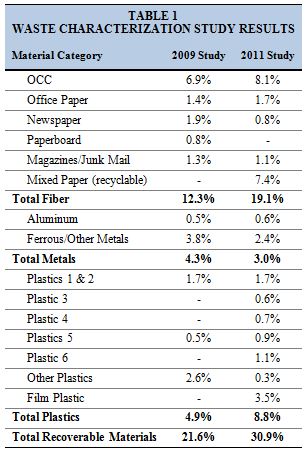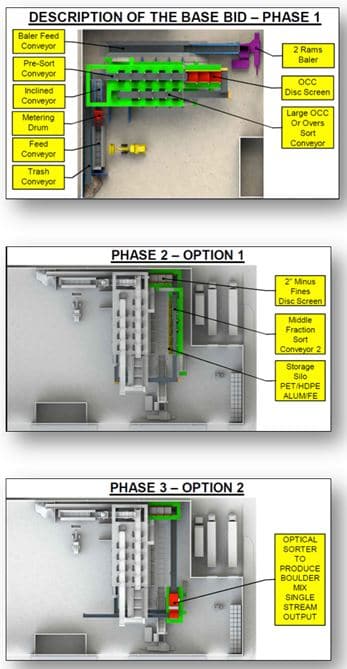Gary Horton and Karl R. Hufnagel
The City of Boulder, CO, and the surrounding environments, are known for their environmental awareness and green practices, including the community’s interest and efforts in responsible management of their solid waste stream. Western Disposal Services (Western) is a privately owned, regional waste management company that serves more than 40,000 residential and 4,200 commercial customers in the city and surrounding Boulder and Broomfield counties—a geographical area of 726 square miles. Western provides collection service for trash, source-separated recyclables, and compostable materials. As part of its services to the Boulder area, Western operates a waste transfer station that receives self-haul and contract collected trash, construction and demolition (C&D) materials, organic materials, and bulky and difficult to handle wastes. In addition, Western also operates a nearby composting facility. In 2011, Western handled more than 170,000 tons of trash, recyclables and compostables at its 16-acre campus facility on the eastern edge of the city.
Even though the Boulder community has well-established recyclables diversion programs, Western recognizes that the mixed waste it is collecting from the residential, multi-family and commercial customers contains significant amounts of valuable recyclable materials, including old corrugated containers (OCC), mixed paper, aluminum, plastics and scrap metals. Western also is aware that the trend in the industry is to focus on higher levels of material diversion from the waste stream and that similarly positioned firms are finding success in expanding into this market area.
Wanting to do its part in increasing the community’s recyclables diversion, improve its overall profitability and update its aging transfer building, Western engaged SAIC (McLean, VA), a FORTUNE 500® scientific, engineering, and technology applications company, to help evaluate the technical and financial feasibility of constructing a combined transfer and mixed waste processing facility, or “Dirty” Material Recovery Facility (MRF), that would provide Western with the ability to divert some of this recyclable material.
Project Development
The project started in April 2011 with initial consultation and information gathering to develop an understanding of Western’s objectives, waste flow information and the nature of the physical layout of Western’s facility campus in Boulder. Western and SAIC then took a straightforward approach to evaluating the technical and economic feasibility of implementing a mixed waste processing system for the commercial waste stream. The approach included the following key steps:
- Develop a comprehensive understanding of the current and future characteristics and quantity of recoverable material in the commercial waste stream.
- Develop an understanding of Western’s facility campus and the potential challenges for developing a new combined transfer station and material processing facility (transfer station/MRF) on the site, given the many other functions that occur on the site.
- Work with material processing equipment vendors to develop conceptual layouts for various processing systems (including possible phased development), that would allow Western to separate out materials cost effectively for sale into the recyclable materials marketplace.
- Develop a conceptual transfer/MRF building footprint layout that would accommodate the selected processing equipment arrangement and the facilities needed for continued MSW transfer.
- Assess the feasibility of locating the proposed facility on Western’s campus site and the functional and capital cost impacts that it would have on the other operating facilities at the site.
- Develop detailed cost estimates for design, permitting, construction, equipment, operating and maintenance of the new facilities including the various processing system alternatives under consideration.
- Develop and apply a business case model for each processing system alternative under consideration in order to analyze a range of possible financial scenarios (from conservative to optimistic) depending on the following six primary model inputs:
- Tonnage of waste stream materials processed
- Percentage of the waste stream expected to be recovered for targeted material categories
- Operating and maintenance cost per ton of material processed (highly weighted toward operating labor cost)
- Market value of recovered material (a highly volatile set of values)
- Cost of facilities (capital plus financing cost)
- Avoided cost for disposal of recovered materials
- Because the model results proved to be highly sensitive to variations in the waste composition data and inconclusive, conduct an additional waste characterization study of the commercial waste stream to increase the confidence level in the percentage of targeted materials input to the model and therefore in the model results.
Steps 1 through 7 were accomplished over a period of approximately six months in 2011. The additional waste characterization study was completed in April 2012.
Project Challenges
Understanding the Waste Stream Composition
Having reliable waste stream composition data is an essential prerequisite for the business case analysis. Western was able to provide a waste characterization study of the commercial waste stream that was about 1.5 years old—recent enough to give a decent initial basis for understanding the categories and potential quantities of recoverable materials. The key material categories and the apparent percentages by weight are listed in the center column of Table 1.
However, in Step 8, Western and SAIC conducted an additional waste characterization study, and the results of this study are shown in the right-hand column of Table 1 and reflect the mean values for these categories. Finalization of the business case analyses (Step 7) will use these more recent values.
Conceptualizing the Processing System Alternatives and Establishing Reliable System Performance Expectations
Each mixed waste processing system is unique and must be designed by knowledgeable system design staff. Often, this is accomplished in a collaborative effort by the processing system manufacturer and the facility design engineer. Figures 2 to 4 show how typical conceptual equipment arrangements were developed by the preferred vendor for several phases of development for Western’s facility.
The preliminary design process used in Step 3 resulted in a proposed four-phase development from the preferred vendor that would allow Western to focus on the “low-hanging fruit” in the waste stream of OCC, aluminum and ferrous metal in the first phase. Subsequent phases, if implemented, install additional processing equipment that would add various categories of paper and plastics or alternatively a commingled mix of recyclables that would then be trucked a short distance to a single stream MRF operated by Boulder County for further separation.
Developing Reliable Capital, Equipment and Operating Cost Estimates
A business contemplating a significant capital and operating system investment must have a reliable business case analysis on which to base its decision. The business case must in turn be based on realistic and accurate cost estimates. Shortcuts taken in analyzing all the costs can spell disaster. Understanding this imperative, Western and SAIC developed comprehensive capital, operating and maintenance cost estimates founded on a systematic assessment of the facilities needed and the staffing required to operate the MRF.
Cost was only one part of the financial equation. Accurate, reliable projections of the long-term revenue generation were also required, and these were based on pragmatic projections of the amount and quality of material that could be recovered using the processing system, and on the long-term market value of these materials.
Recognizing Model Sensitivities
The business model is sensitive to several key input factors, which necessitates careful consideration of the range of possible output results. Because of the higher market value of aluminum and other metals, the model is particularly sensitive to both projected quantities and to market values assigned to these materials. The other recovered materials having lower market values have less influence on the model output, but collectively, the market values of all recovered materials have fluctuated widely and are volatile. Therefore the volatility of commodity values is a significant issue in the assessment process.
System operating cost is also a very influential factor in the model results. Because labor is the single most important factor in system operating cost, the model is very sensitive to the operating staff assumptions. Furthermore, the decision on how much labor will be required to operate efficiently will also have a direct effect on how much of the available material is recovered and the quality of that material. A balance must be found to optimize system recovery rates and material quality with labor costs as this equates directly to the revenue produced.
Results
The initial business case analyses were inconclusive. The model runs that used conservative inputs showed that a new mixed waste processing system might operate at a small loss. Model runs using more optimistic inputs showed that the system might operate at a small profit. The reliability of the results fell outside the level of confidence Western needed to make a final business decision.
A major financial drag on the system was the capital cost of replacing existing unrelated facilities that would be displaced to make room for the new transfer/MRF building. These capital costs approached the magnitude of the cost of the transfer/MRF facility itself. The analyses also demonstrated the model’s sensitivity to the quantity of material recovered, particularly the higher value materials such as aluminum and other metals.
The results pointed to the need to increase the confidence in the quantity of recoverable materials, which precipitated the recently completed waste characterization study. In addition, the results pointed to the need to site the new transfer/MRF facility at a different location that would not require costly investment in other replacement facilities.
A new “greenfield” site has been identified and preparation of new capital cost estimates for the transfer/MRF facility on this site is currently underway. The results of the business case analyses for this site have proven much more conclusive and favorable.
Gary Horton has been with Western Disposal Services for 30-plus years, progressing from controller to president. Under his leadership the company has continually adapted its services to meet the needs of the community as it moved from little or no waste diversion to over 50 percent diversion for its residents and 25 percent for its commercial and industrial residents. Gary can be reached at [email protected].
Karl Hufnagel, a senior project manager with SAIC, has more than 40 years of experience in facility planning and design engineering for industrial and municipal clients. He can be reached at [email protected].
Table 1
Waste characterization study results.
Table courtesy of SAIC.
Figure 1, 2, 3
Typical conceptual equipment arrangements that were developed by the preferred vendor for several phases of development for Western’s facility.
Figures courtesy of CP Manufacturing.


